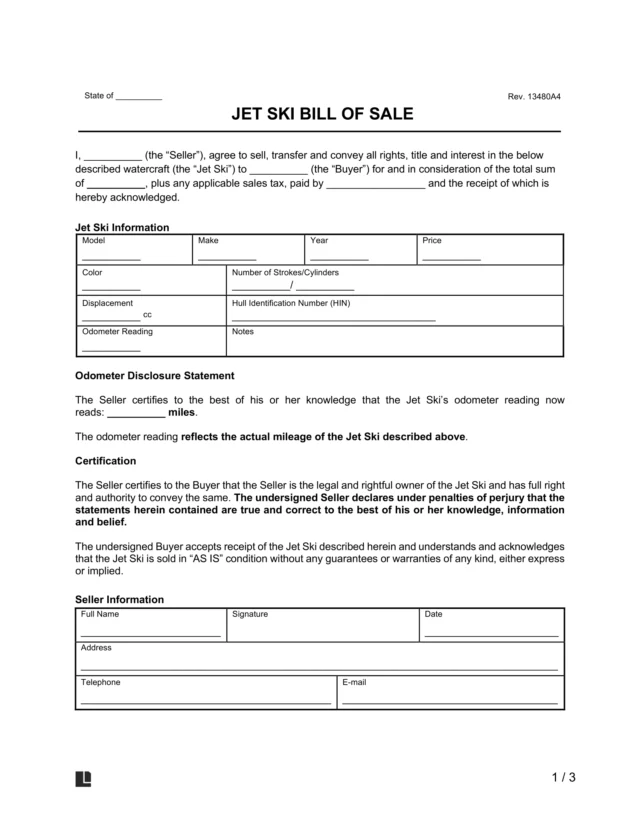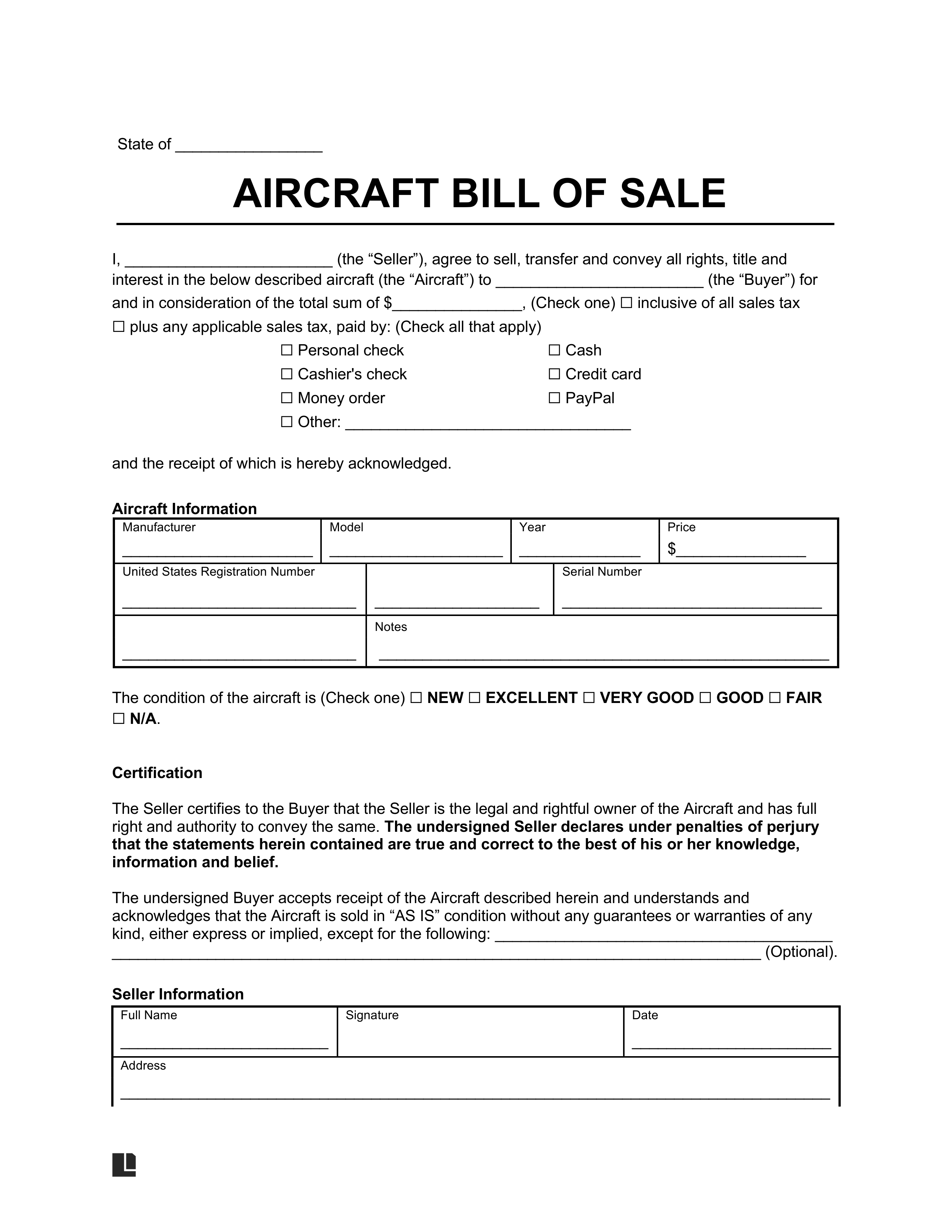What Is an Aircraft Bill of Sale?
An aircraft bill of sale is a written document that records the sale of an aircraft. The Federal Aviation Administration (FAA) relies on it to confirm that ownership has transferred. It identifies the aircraft involved and names both the buyer and seller, tying the ownership transfer to a specific transaction.
Buyers and sellers may use the FAA’s Aircraft Bill of Sale (AC Form 8050-2) or another bill of sale that fits FAA requirements, such as Legal Templates’ form. Either option confirms the transfer of all rights, title, and interests from the seller to the purchaser, and the FAA uses the document when registering the aircraft under the new owner.
When Do You Need an Aircraft Bill of Sale?
You need an aircraft bill of sale whenever ownership of an aircraft transfers, and the transaction must be recorded with the FAA. That typically includes a few common situations:
- When buying or selling an aircraft that the buyer plans to register with the FAA. The FAA relies on the bill of sale to confirm the ownership transfer.
- When registering an aircraft or placing it in a trust under 14 CFR Part 47. The bill of sale serves as official proof of ownership for FAA filings.
- When the aircraft was not purchased directly from the last registered owner, in these cases, the paperwork must clearly show a full chain of ownership to avoid delays.
- When a seller needs proof that the aircraft is no longer theirs, a signed bill of sale helps limit future responsibility after the sale.
Overall, the aircraft bill of sale supports clean FAA records and protects both parties throughout the transfer process.
Is an Aircraft Bill of Sale Legally Binding?
An aircraft bill of sale is legally binding when it is completed correctly and meets FAA requirements. The FAA relies on the document to confirm ownership and issue a registration certificate. To avoid filing issues or delays, a few details need to be handled carefully:
- The purchaser’s name must exactly match the aircraft registration application (AC Form 8050-1). Even minor inconsistencies can cause the FAA to reject or delay the filing.
- All details should be typed or clearly printed. Signatures must be in ink or in an accepted digital format to be valid for recording.
- If the aircraft is sold into co-ownership, every co-owner must sign the bill of sale. Missing signatures can invalidate the transfer for registration purposes.
- The FAA does not require a notarized bill of sale, but some state or local laws may still require acknowledgment for the document to be legally effective.
- The FAA accepts other authorized proof of ownership under 14 CFR § 47.11. However, incomplete or incorrect submissions can prevent or delay the issuance of an aircraft registration certificate.
In practice, a properly prepared bill of sale creates a binding ownership transfer and avoids registration setbacks with the FAA.
What to Include in an Aircraft Bill of Sale
An aircraft bill of sale works as the core document the FAA relies on to record ownership. To avoid registration delays or follow-up requests, the form should clearly capture who is selling the aircraft, who is buying it, and exactly what is being transferred. The key details below help make that happen.
- Date of sale, usually the date the bill of sale is signed.
- State where the sale takes place, which can affect tax and legal requirements.
- Purchase price of the aircraft, including whether the price includes sales tax.
- Accepted payment method, such as cash, check, wire transfer, or electronic payment.
- Warranty terms, stating whether the aircraft is sold with a warranty or on an “as-is” basis, which is common in private sales.
- Aircraft identification details, including the US registration number (N-number), manufacturer, model, and serial number.
- Aircraft usage or time-in-service information, if provided, stated to the best of the seller’s knowledge.
- Buyer’s full legal name, which must exactly match the name on the aircraft registration application.
- Buyer address and contact details, if included in the document.
- Dealer information, such as a certificate number, phone number, or email address, when applicable.
- Seller’s full legal name and address, if included.
- Printed names and signatures of all sellers, with all co-owners signing when the aircraft is sold under co-ownership.
- Trade name usage, listing individual owner names with a trade name but avoiding listing individuals alongside corporations or LLCs to prevent implied co-ownership.
- Separate supporting agreements, often used for homebuilt or restored aircraft, to address liens, inspections, logbooks, maintenance records, “as-is” terms, and indemnity provisions.
Including these elements helps the bill of sale stand on its own as clear proof of ownership. It also allows the FAA to accept the filing without unnecessary back-and-forth.
An aircraft bill of sale records the ownership transfer, but other documents often support the airplane sale:
- A purchase and sale agreement to set out the price, inspections, and closing terms
- An invoice to document the purchase price and payment details
- A payment agreement, when the buyer pays over time rather than all at once
Does an Aircraft Bill of Sale Transfer Ownership?
An aircraft bill of sale transfers ownership by documenting the transfer of rights, title, and interests in the aircraft. The FAA relies on the bill of sale as proof that ownership has moved from the seller to the buyer.
However, registration is a separate step. The aircraft needs to be registered before it can be legally operated. To do that, the buyer submits the bill of sale along with the aircraft registration application.
Timing also plays a role. The FAA generally treats the owner as the party who files the bill of sale and registration first. If filing is delayed, gaps can appear in the record, which might create ownership confusion or liability risk if something happens before registration is complete.
Some airplane sales use escrow to hold funds or documents until inspections, repairs, or other agreed conditions are met. An escrow holdback agreement can help spell out when those funds or documents are released.
How to File an Aircraft Bill of Sale
You can file the bill of sale by mail with the FAA Aircraft Registration Branch in Oklahoma City or submit it online through CARES.FAA.gov. Registration and recording usually include a $5 fee to issue a certificate of aircraft registration, with extra fees applying in certain situations, such as conditional sales contracts or recorded conveyances.
Sample Aircraft Bill of Sale
View a sample aircraft bill of sale to see how the document is structured. Then, customize and download the template as a PDF or Word file to use for your transaction.






